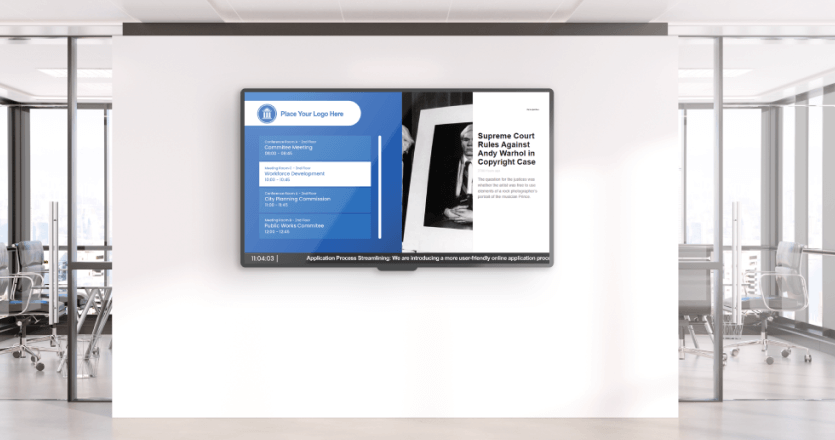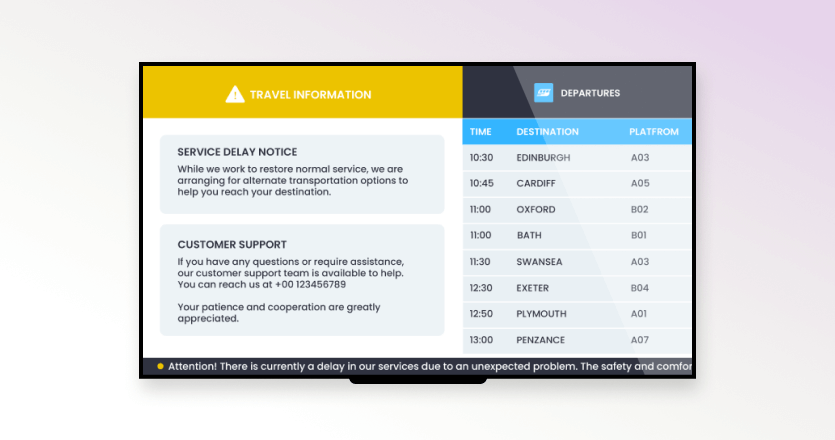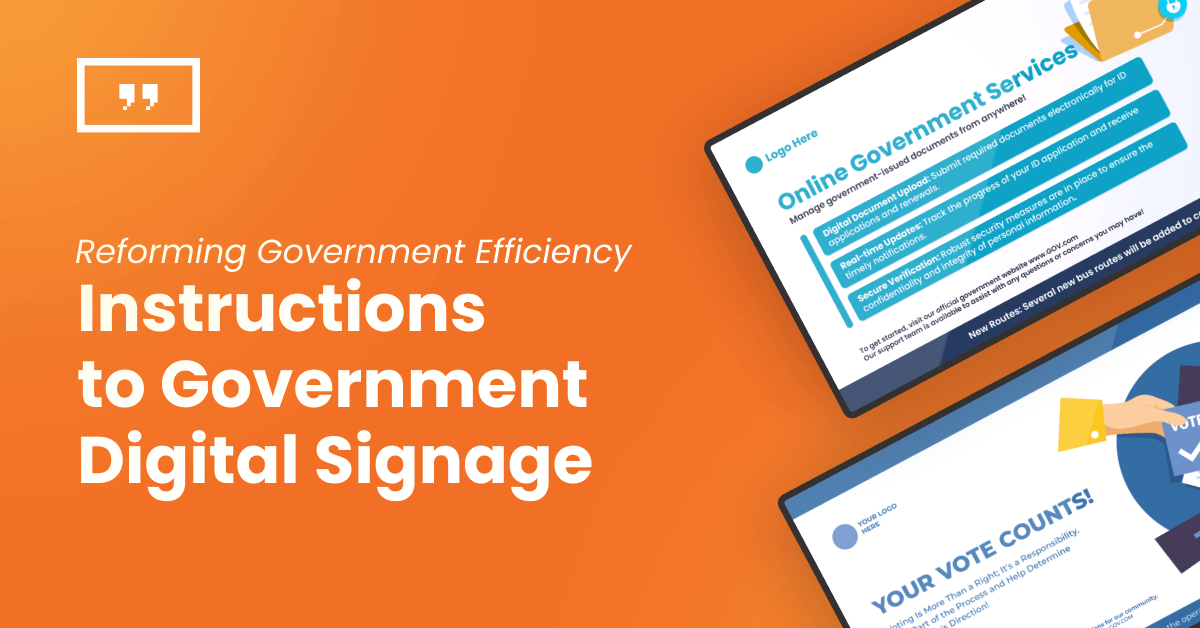Traditional methods of communication in government institutions often fall short, causing frustration among citizens and staff alike. In many cases, people hesitate to visit a government office due to long queues, inefficient communications, and delayed relay of public information. One solution for these institutions is hiring more people, which is often challenging and doesn’t guarantee definite success. A more effective and cost-efficient second solution is digital signage.
Digital signage not only addresses communication and queue-related issues but also modernizes and enhances efficiency in government institutions, particularly in areas that require improved support for better citizen assistance. Yodeck proposes solutions and ideas on how and where to deploy digital signage screens for more effective communication and assistance.
What is Government Digital Signage?
Government digital signage is a transformative communication solution that leverages electronic displays strategically placed within government facilities. These dynamic displays serve as a powerful channel for conveying information, announcements, and updates, bridging the gap between bureaucrats and the public. Unlike static communication methods, digital signage allows for real-time updates, ensuring citizens are promptly informed about crucial matters.
Why should Governments use Digital Signage?
Improved Communication
One of the primary challenges government offices face is the efficient dissemination of information to the public. Traditional methods, such as bulletin boards and paper-based communication, often result in delayed updates and a lack of engagement. Government digital signage addresses this issue by offering a visually compelling platform for communicating announcements, policy changes, and other essential information. Even a digital bulletin board will make a huge change. The dynamic nature of digital displays captures attention and ensures that the public receives timely updates, fostering a more informed and engaged community.
Enhanced Accessibility
Accessibility is a cornerstone of effective governance. Digital signage ensures that information is easily accessible to everyone, including individuals with disabilities. Features like text-to-speech capabilities and high-contrast displays cater to diverse needs, making government information more inclusive. Whether it’s emergency alerts, event notifications, or general announcements, digital displays contribute to a more accessible and transparent government environment.
Save Money & Time
Investing in government digital signage is not just a technological upgrade; it’s a strategic move that yields actual benefits in terms of cost savings and time efficiency. Reducing paper usage, printing costs, and manual labor associated with traditional communication methods translates into substantial long-term savings. Moreover, the ability to update information instantly reduces the time lag between decision-making and communication, streamlining processes and enhancing overall efficiency.
Assistance in Unsupervised Areas
Government facilities often have areas that are not continuously supervised, posing a challenge in transporting important information. Digital signage is a constant source of information in these unsupervised spaces, assisting visitors and citizens even when direct supervision is impossible. Whether it’s an informational kiosk or a display in a waiting area, digital signage ensures that crucial information is always available, contributing to a more user-friendly experience.
Environmentally Friendly Solution
Moving to digital communication in government facilities reduces the ecological footprint of traditional methods, conserving trees and cutting paper production. This aligns with environmental goals, sets a positive community example, and promotes energy-efficient digital displays. This shift enhances the government’s image and fosters an environmentally conscious communication approach, setting a precedent for broader community sustainability.

Locations for Digital Signage
- Entrance
- Hallways
- Lobby
- Offices
Strategic placement of digital signage is crucial for maximizing its impact. Placing displays at entrances, hallways, lobbies, and office rooms ensures that information is disseminated effectively as individuals navigate through different spaces within the facility. Entrance displays can provide general information, hallways can feature upcoming events, lobbies can showcase community initiatives, and room displays can offer specific details related to the respective area.
How can the Government Industry use Digital Signage?
Command Centers, Common Areas, Community Centers
The versatility of digital signage makes it applicable across various government spaces. In command centers, real-time updates and critical information can be displayed to ensure decision-makers have the latest information at their fingertips. Common areas and community centers benefit from digital signage by fostering a sense of community through announcements, event promotions, and local initiatives. The visually engaging nature of digital displays captures attention and encourages citizen participation.
Queue Control, Docket Updates, Emergency Alerts
Managing queues efficiently is a common challenge in government offices, particularly in service-oriented departments. Digital signage can be employed for queue management, providing clear instructions and updates to individuals waiting in line. For courts and legal offices, docket updates can be displayed in real-time, reducing confusion and ensuring that participants are well informed. In emergencies, digital signage is critical for delivering timely alerts and instructions, enhancing public safety and response coordination.
First Response, Language Translation, Staff Communication
During critical situations, such as natural disasters or public emergencies, digital signage plays a crucial role in first-response communication. Emergency procedures, evacuation routes, and safety instructions can be displayed instantly, aiding in crisis management. Language translation features further broaden the information reach, making it accessible to a diverse population with varying language preferences. For internal communication, digital signage facilitates seamless staff communication, providing updates on policies, schedules, and important announcements.
Wayfinding, Event & Visitor Management
Navigating large government facilities can be a daunting task for visitors. Digital signage alleviates this challenge by effortlessly providing wayfinding information and guiding visitors to their destinations. Whether it’s directing individuals to specific offices, conference rooms, or service counters, digital displays enhance the overall visitor experience. In event management, digital signage becomes a valuable tool for displaying event schedules, directions, and important updates for staff and visitors attending government-hosted events.

Digital signage leads a new way into government communications, offering dynamic and visually engaging displays that meet evolving citizen needs and position government offices at the forefront of technological innovation. As we envision a future where seamless communication is paramount, government digital signage stands as an example of progress, connecting officials and citizens in exceptional ways.
